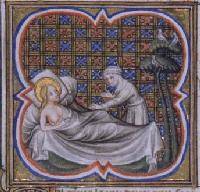 Also known as Saint Elizabeth of Hungary — Szent Erzsébet in her native tongue — Elisabeth (also Erzsebet) was born in Sárospatak in 1207, the daughter of King Andrew II and his wife Gertrude. When only four years old, she was betrothed by parental arrangement to Ludwig (Louis), son of Hermann I, Landgrave of Thuringia, and Duchess Sophia. At this tender age, the child moved to the Thuringian court. She married him in 1220, when just fourteen. He was only twenty and had been ruling as Ludwig IV since 1217.
Also known as Saint Elizabeth of Hungary — Szent Erzsébet in her native tongue — Elisabeth (also Erzsebet) was born in Sárospatak in 1207, the daughter of King Andrew II and his wife Gertrude. When only four years old, she was betrothed by parental arrangement to Ludwig (Louis), son of Hermann I, Landgrave of Thuringia, and Duchess Sophia. At this tender age, the child moved to the Thuringian court. She married him in 1220, when just fourteen. He was only twenty and had been ruling as Ludwig IV since 1217.Her spirit of Christian generosity and charity pervaded the home she established for her husband and three children in the Wartburg Castle at Eisenach. Their abode was known for hospitality and family love.
Elisabeth often supervised the care of the sick and needy, even giving up her bed to a leper at one time. Unlike many medieval men, particularly the rulers, Louis encouraged her efforts and contributed directly to them. This seems due, in large part, to a faith that depended much upon works in order to guarantee eternal reward — or, at least, to avoid Purgatory.
When she was widowed at 20, circumstances drastically changed. Already possessed of a charitable heart, Elisabeth increased her work on behalf of others — her confessor, the inquisitor Konrad von Marburg, encouraging (or pushing) her growing spiritual discipline. Some accounts say that Konrad not only enforced his will through a strong personality but that he also resorted to beatings and separating her from her children.
 Later, she arranged for her children's well-being and entered into life as a nun in the Order of Saint Francis. Her self-denial, quite possibly abetted by harsh treatment at the hands of her confessor, led to failing health and an early death in 1231 at age 24. Remembered for her self-sacrificing ways, Elisabeth is commemorated through the many hospitals named for her around the world.
Later, she arranged for her children's well-being and entered into life as a nun in the Order of Saint Francis. Her self-denial, quite possibly abetted by harsh treatment at the hands of her confessor, led to failing health and an early death in 1231 at age 24. Remembered for her self-sacrificing ways, Elisabeth is commemorated through the many hospitals named for her around the world.She was laid to rest in a gold shrine in Elisabeth Kirche in Marburg. The second illustration above is a scene of her helping the poor from that church's Elizabeth Window. Her popular cultus, aided in large part by political considerations, led to a rapid canonization. In 1235, Pope Gregory IX named her St. Elisabeth. Her official canonization ceremony was Pentecost (28 May), only about three and a half years after her death. The lasting effect she had on individuals, the Church, and on health care have led many to call her "the greatest woman of the German Middle Ages."
As we see from Rosenwunder: Wege zu Elisabeth von Thüringen, Elisabeth was the 2007 "cultural theme" for Erfurt. Along with Elisabeth Kirche, this site has a wealth of additional information and illustrations.
Note: For Lutherans, Wartburg Castle holds special significance because of events happening some three hundred years later. It was to the Wartburg that friends moved Martin Luther in 1521 to escape enforcement of the imperial ban and possible death. Hiding under the name Junker Jörg (Knight George), Luther employed himself by continuing his doctrinal and polemical writing and translating the New Testament.
Lection
Psalm 146:4-9 or 112:1-9
Tobit 12:6b-9
Matthew 25:31-40 or Luke 12:32-34
Collect
Almighty God, by whose grace your servant Elisabeth of Thuringia recognized and honored Jesus in the poor of this world, grant that we, following her example, may with love and gladness serve those in any need or trouble, in the name and for the sake of through Jesus Christ our Lord, who lives and reigns with you and the Holy Spirit, one God, now and forever.
Technorati Tags: Elisabeth of Thuringia | Saint Elisabeth of Thuringia | St. Elisabeth von Thüringen | Elizabeth of Hungary | Saint Elizabeth of Hungary | St. Elizabeth of Hungary | Szent Erzsébet | Erzebet | Ludwig IV of Thuringia | Louis IV of Thuringia | Konrad von Marburg | Conrad of Marburg | Hungary | Germany | Sárospatak | arospatak | Thuringia | Eisenach | Wartburg Castle | charity | healing | hospitals | Church Year | liturgical calendar | sanctorial calendar | Christianity | Christian | Lutheran | Lutheranism | Christian feasts | festivals | saints' days | biography | hagiography | commemoration | theology | historical theology | history | Church history | Christian history | European history | German history | Hungarian history | Thuringian history | Medieval history | Aardvark Alley

